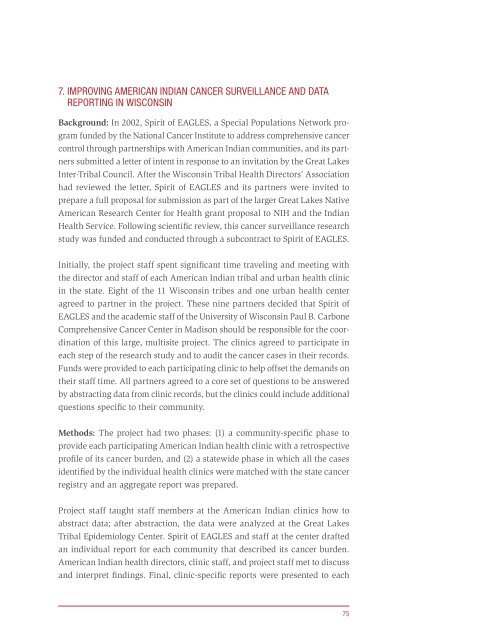Principles of Community Engagement (Second Edition)
Principles of Community Engagement (Second Edition)
Principles of Community Engagement (Second Edition)
You also want an ePaper? Increase the reach of your titles
YUMPU automatically turns print PDFs into web optimized ePapers that Google loves.
7. IMPROVING AMERICAN INDIAN CANCER SURVEILLANCE AND DATA<br />
REPORTING IN WISCONSIN<br />
Background: In 2002, Spirit <strong>of</strong> EAGLES, a Special Populations Network pro-<br />
gram funded by the National Cancer Institute to address comprehensive cancer<br />
control through partnerships with American Indian communities, and its part-<br />
ners submitted a letter <strong>of</strong> intent in response to an invitation by the Great Lakes<br />
Inter-Tribal Council After the Wisconsin Tribal Health Directors’ Association<br />
had reviewed the letter, Spirit <strong>of</strong> EAGLES and its partners were invited to<br />
prepare a full proposal for submission as part <strong>of</strong> the larger Great Lakes Native<br />
American Research Center for Health grant proposal to NIH and the Indian<br />
Health Service Following scientific review, this cancer surveillance research<br />
study was funded and conducted through a subcontract to Spirit <strong>of</strong> EAGLES<br />
Initially, the project staff spent significant time traveling and meeting with<br />
the director and staff <strong>of</strong> each American Indian tribal and urban health clinic<br />
in the state Eight <strong>of</strong> the 11 Wisconsin tribes and one urban health center<br />
agreed to partner in the project These nine partners decided that Spirit <strong>of</strong><br />
EAGLES and the academic staff <strong>of</strong> the University <strong>of</strong> Wisconsin Paul B Carbone<br />
Comprehensive Cancer Center in Madison should be responsible for the coordination<br />
<strong>of</strong> this large, multisite project The clinics agreed to participate in<br />
each step <strong>of</strong> the research study and to audit the cancer cases in their records<br />
Funds were provided to each participating clinic to help <strong>of</strong>fset the demands on<br />
their staff time All partners agreed to a core set <strong>of</strong> questions to be answered<br />
by abstracting data from clinic records, but the clinics could include additional<br />
questions specific to their community<br />
Methods: The project had two phases: (1) a community-specific phase to<br />
provide each participating American Indian health clinic with a retrospective<br />
pr<strong>of</strong>ile <strong>of</strong> its cancer burden, and (2) a statewide phase in which all the cases<br />
identified by the individual health clinics were matched with the state cancer<br />
registry and an aggregate report was prepared<br />
Project staff taught staff members at the American Indian clinics how to<br />
abstract data; after abstraction, the data were analyzed at the Great Lakes<br />
Tribal Epidemiology Center Spirit <strong>of</strong> EAGLES and staff at the center drafted<br />
an individual report for each community that described its cancer burden<br />
American Indian health directors, clinic staff, and project staff met to discuss<br />
and interpret findings Final, clinic-specific reports were presented to each<br />
75

















